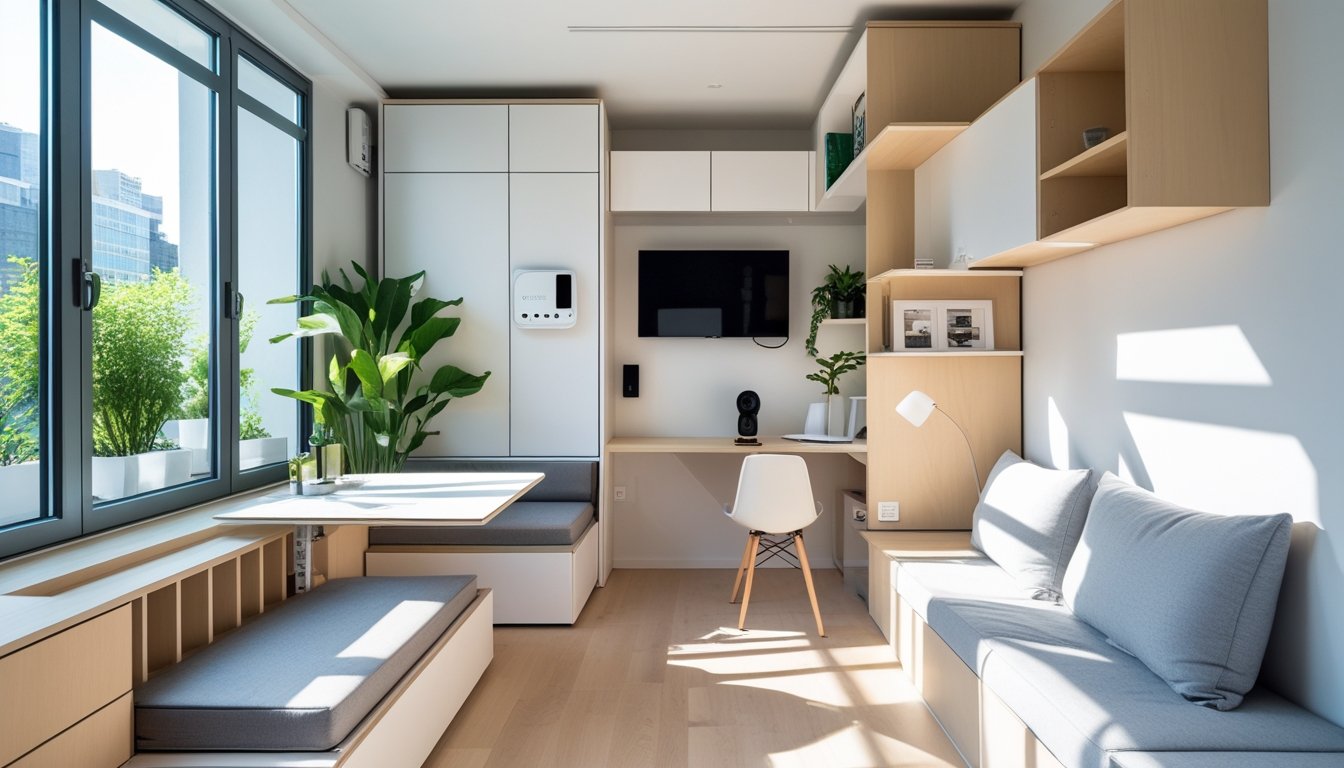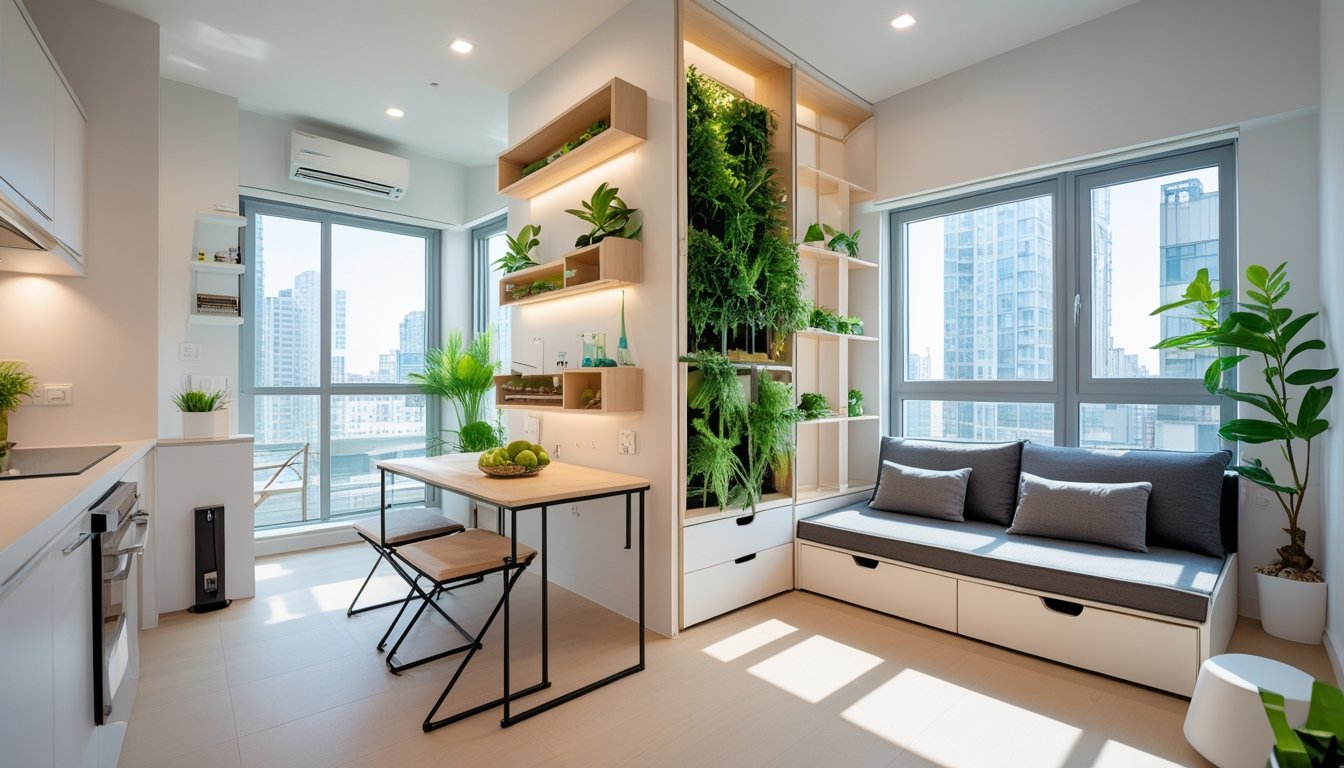Late updated: 01 Nov 2025 11:11
Written by: Daniel Harper
Innovative Design Ideas For Compact Urban Living: Maximising Space and Style
Building a home in the city doesn't always come with the luxury of space. Urban living often means making do with compact spaces, which can pose both challenges and opportunities. Our goal is to transform these challenges into creativity-driven solutions that maximise space, functionality, and style. By blending innovative design concepts, we can create an inviting living environment without sacrificing the unique energy that urban living offers.

In the heart of bustling cityscapes, where every square inch is precious, design innovation becomes a necessity. We explore the artistry of space-saving solutions, multifunctional furniture, and smart storage ideas that redefine compact living. These concepts are not just about aesthetics but also about creating a practical and comfortable home that reflects the dynamism of city life.
As urbanisation continues to shape our cities, the demand for efficient and stylish homes escalates. We believe that with the right approach, even the smallest space can be a vibrant oasis, showcasing the perfect balance between design and functionality. Let's venture into a world where compact living becomes an art form in itself.
Key Takeaways
- Innovative design can transform compact urban spaces into inviting homes.
- Smart solutions ensure every square inch is used efficiently.
- Multifunctional designs blend practicality with aesthetic appeal.
Core Principles of Innovative Design for Compact Urban Living
To thrive in compact urban spaces, optimal design principles must be embraced. Our focus lies in creating innovative solutions for limited spaces, promoting sustainability, and maximising natural resources. By incorporating these strategies, we can transform small dwellings into efficient, eco-friendly environments.
Space Optimisation Strategies
Urban living often requires making the most of limited space. Multi-functional furniture and intelligent storage solutions are crucial. For example, beds with storage underneath or tables that fold into the wall help maximise utility with minimal footprint.
Wall-mounted shelving can free up precious floor space. Transformative design methods, like sliding walls or pivoting bookcases, allow for adaptable room configurations. Integrating open-plan layouts can create a sense of spaciousness, making small homes feel larger than their actual size.
Every corner must be utilised efficiently. Using vertical space for storage or decoration can enhance both functionality and visual appeal. The key lies in choosing versatile furnishings and creative layouts which accommodate daily activities and personal lifestyle needs within the constraints of compact living.
Sustainable and Eco-Friendly Design
Sustainability plays a vital role in contemporary urban dwelling. Selecting eco-friendly materials like bamboo, reclaimed wood, or recycled metal can reduce environmental impact. Implementing energy-efficient systems such as solar panels or energy-efficient appliances decreases utility costs and supports sustainability.
Compact homes can benefit from green technologies, like smart meters, which track and optimise energy consumption. Insulation improvements and environmentally friendly building techniques enhance energy efficiency and promote sustainable living. By prioritising sustainable design, we ensure our urban spaces contribute positively to both inhabitants and the environment.
Water conservation should also be considered, with low-flow fixtures and rainwater harvesting systems being viable options. Sustainable solutions not only foster environmentally conscious living but also create healthier indoor environments.
Enhancing Natural Light and Ventilation
A well-lit, ventilated home improves both comfort and wellbeing. To make the most of natural light, strategically-placed windows and glazed doors are effective. This aids in reducing reliance on artificial lighting, thus saving energy and enhancing space perception.
Use of translucent furniture and light-coloured walls helps reflect natural light, brightening interiors. Mirrors can be employed to scatter light throughout compact spaces, enhancing the sense of openness.
Proper ventilation systems, including cross ventilation, ensure an inflow of fresh air, maintaining air quality. Rooftop gardens or green roofs can enhance air quality while cooling the living space naturally. Through intelligent design, small homes can be both vibrant and comfortable, utilising natural elements efficiently.
Innovative Solutions for Maximising Small Urban Spaces

In urban environments, space constraints demand creative and effective solutions. Innovative design solutions can help transform compact areas into comfortable and stylish living spaces. Let's explore how multi-functional and modular furniture, smart and flexible layouts, clever storage techniques, and wellbeing enhancements through technology can redefine small urban living.
Multi-Functional and Modular Furniture
Furniture in compact spaces needs to be versatile and space-saving. Multi-functional furniture like sofa beds and murphy beds can efficiently double up as both sleeping and seating areas. Modular sofas offer flexibility by allowing rearrangement to fit different purposes. Storage solutions like storage ottomans and fold-out desks provide dual functionality: serving as a furniture piece and a storage unit. An extendable dining table can be a game-changer, accommodating guests when needed and saving space when not. These furnishings highlight the importance of integrating practical use without sacrificing style. They offer a variety of ways to maximise space without cluttering the room.
Smart and Flexible Layouts
Creating a smart layout is key to making the most of limited space. Open floor plans promote fluid movement and make rooms feel larger. Using moveable partitions or sliding doors can create flexible environments that adapt to different needs throughout the day. High ceilings paired with cleverly placed mirrors amplify the perception of space, making rooms feel more open. Additionally, designing layouts that integrate curtains instead of walls for room division can maintain privacy while enhancing spatial flexibility. Such arrangements allow for dynamic living environments that change along with the residents' requirements, providing both functionality and comfort.
Clever Storage and Vertical Expansion
In small urban spaces, every inch counts, so maximising storage is essential. Built-in storage solutions offer a seamless appearance without taking up additional space. Hidden storage options like under-bed storage can keep items out of sight but within reach. Vertical space should not be overlooked; vertical storage using shelves or green walls can add functionality and aesthetics. Expanding upwards with vertical gardens or even rooftop gardens can bring in elements of nature, enhancing the quality of life. These solutions focus not only on keeping things organised but also on making the best use of available space creatively.
Wellbeing, Comfort and Technology Integration
As we design for maximum usability, integrating elements that promote wellbeing is crucial. Smart home technology like automated lighting and smart thermostats help create a convenient, comfortable living environment. Climate control systems with smart lighting can adapt to natural light levels, offering optimal comfort while improving energy efficiency. Incorporating green spaces and using materials like reclaimed wood can further enhance comfort while supporting sustainability. Noise reduction can be achieved using specific design elements, improving the overall sense of tranquility. These integrations ensure that our compact spaces are not just functional but also nurturing and harmonious environments.
Frequently Asked Questions

Innovative design in compact urban living spaces focuses on integrating smart furniture solutions, maximising utility through multifunctional rooms, and leveraging natural light. It also involves using vertical space creatively and incorporating advanced technologies to enhance functionality.
What are the most effective space-saving furniture solutions for small apartments?
Space-saving furniture is key in compact urban living. Convertible pieces, like sofa beds and extendable dining tables, make optimal use of limited areas. Wall-mounted desks and fold-away furniture offer flexibility without sacrificing style or comfort. Additionally, built-in storage solutions can keep clutter hidden, making the space feel more open.
How can multifunctional rooms be designed to maximise utility in a compact living space?
Designing multifunctional rooms necessitates practical planning. Using sliding partitions can seamlessly transform a single room into distinct living and workspace areas. Incorporating movable furniture and custom modules enhances adaptability, allowing a single space to serve various purposes from entertaining to relaxing.
What are the best practices for incorporating natural light in confined urban dwellings?
Natural light can significantly improve the ambience of small urban flats. Maximising window space by using sheer curtains or blinds allows more light in. Mirrors strategically placed opposite windows can amplify natural light throughout the room. Choosing lighter colours for walls and furnishings can also enhance brightness and create a feeling of spaciousness.
How can vertical space be used creatively to enhance living environments with limited square footage?
Vertical storage solutions are vital in making the most of small living spaces. Installing tall shelving units or cabinetry can keep items off the floor, providing more room for movement. Hanging planters and artwork draw the eye upwards, creating the illusion of height. Built-in units can also maximise every available inch without cluttering the floor.
What role do smart home technologies play in improving the functionality of compact urban homes?
Smart home technologies are increasingly integral in compact living. Voice-activated assistants and automated lighting systems provide convenience and efficiency. Smart thermostats save energy while maintaining comfort. Integrating these technologies can streamline daily tasks and optimise energy use, making even the smallest spaces more functional and enjoyable.
How can design elements contribute to the illusion of space in tightly-packed urban living quarters?
The strategic use of design elements can make spaces appear larger. Open floor plans with minimal barriers allow for greater flow. Selecting furniture with raised legs gives the illusion of more space. Utilising a cohesive colour palette and reflective surfaces can make living quarters feel expansive. Using textiles and decor sparingly prevents overcrowding.
